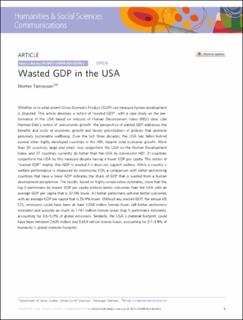| dc.contributor.author | Tønnessen, Morten | |
| dc.date.accessioned | 2023-10-24T11:17:45Z | |
| dc.date.available | 2023-10-24T11:17:45Z | |
| dc.date.created | 2023-10-22T13:49:46Z | |
| dc.date.issued | 2023-09 | |
| dc.identifier.citation | Tønnessen, M. (2023) Wasted GDP in the USA. Humanities & Social Sciences Communications, 10 (1), 681 (2023). | en_US |
| dc.identifier.issn | 2662-9992 | |
| dc.identifier.uri | https://hdl.handle.net/11250/3098372 | |
| dc.description.abstract | Whether or to what extent Gross Domestic Product (GDP) can measure human development is disputed. This article develops a notion of “wasted GDP”, with a case study on the performance of the USA based on analysis of Human Development Index (HDI) data. Like Herman Daly’s notion of ‘uneconomic growth’, the perspective of wasted GDP addresses the benefits and costs of economic growth and favors prioritization of policies that promote genuinely sustainable wellbeing. Over the last three decades, the USA has fallen behind several other highly developed countries in the HDI, despite solid economic growth. More than 20 countries, large and small, now outperform the USA on the Human Development Index, and 27 countries currently do better than the USA by nonincome HDI. 21 countries outperform the USA by this measure despite having a lower GDP per capita. The notion of “wasted GDP” implies that GDP is wasted if it does not support welfare. While a country´s welfare performance is measured by nonincome HDI, a comparison with better-performing countries that have a lower GDP indicates the share of GDP that is wasted from a human development perspective. The results, based on highly conservative estimates, show that the top 5 performers by lowest GDP per capita achieve better outcomes than the USA with an average GDP per capita that is 37.5% lower. All better performers achieve better outcomes with an average GDP per capita that is 26.9% lower. Without any wasted GDP, the annual US CO2 emissions could have been at least 1.268 million tonnes lower (all better performers estimate) and possibly as much as 1.767 million tonnes lower (top 5 performers estimate), accounting for 3.6–5.0% of global emissions. Similarly, the USA´s material footprint could have been between 2.625 million and 3.659 million tonnes lower, accounting for 2.7–3.8% of humanity´s global material footprint. | en_US |
| dc.language.iso | eng | en_US |
| dc.publisher | Springer Nature Switzerland AG | en_US |
| dc.rights | Navngivelse 4.0 Internasjonal | * |
| dc.rights.uri | http://creativecommons.org/licenses/by/4.0/deed.no | * |
| dc.title | Wasted GDP in the USA | en_US |
| dc.type | Peer reviewed | en_US |
| dc.type | Journal article | en_US |
| dc.description.version | publishedVersion | en_US |
| dc.rights.holder | © The Author(s) 2023 | en_US |
| dc.subject.nsi | VDP::Samfunnsvitenskap: 200 | en_US |
| dc.source.pagenumber | 0 | en_US |
| dc.source.volume | 10 | en_US |
| dc.source.journal | Humanities & Social Sciences Communications | en_US |
| dc.source.issue | 1 | en_US |
| dc.identifier.doi | 10.1057/s41599-023-02210-y | |
| dc.identifier.cristin | 2187351 | |
| dc.source.articlenumber | 681 (2023) | en_US |
| cristin.ispublished | true | |
| cristin.fulltext | original | |
| cristin.qualitycode | 1 | |

